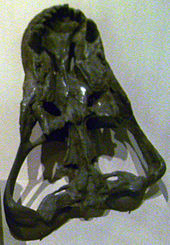Theriognathus
| Theriognathus | |
|---|---|

| |
| T. microps Fossil | |
| Scientific classification | |
| Domain: | Eukaryota |
| Kingdom: | Animalia |
| Phylum: | Chordata |
| Clade: | Synapsida |
| Clade: | Therapsida
|
| Clade: | †Therocephalia |
| Family: | †Whaitsiidae |
| Genus: | †Theriognathus Owen, 1876 |
| Type species | |
| Theriognathus microps Owen, 1876
| |
| Synonyms | |
| |
Theriognathus (from Greek therion: beast, mammal, Greek, gnathos, “jaw,” +us, pronounced THEH-ree-OG-nah-thuss) is an
Geography
Theriognathus is represented by abundant occurrences in the
Theriognathus has been found in the
Theriognathus was also found in the Tapinocephalus assemblage zone, which was an odd find since most specimen in that zone tend to be medium to large in size. Theriognathus was an exception to that norm. Diversification was shown by an increase in richness of eutherocephalian groups in the Cistecephalus and Dicynodon assemblage zones. During this time some of the more specialized genera, including Theriognathus, split from pre-existing families.[3]
History of discovery
Theriognathus was first described by
Results from the analysis of a basal
Description/paleobiology
Skull
Skull roof

The anterodorsal-most tip of the premaxilla forms a rostral process, which overhangs the incisors, like in most eutherocephalians. The external nares are relatively large and face anterolaterally. The rostrum is relatively long and about as high as it is broad. A constriction of the snout exists directly behind the caniniforms, causing the snout to look relatively narrow. The posterior region of the maxillary facial plate is folded inward onto the palatal region, like in most non-akidnognathid whaitsioids.[2] The suborbital bar is deep and slightly expanded.[9] It extends from the jugal onto the posterior end of the maxillary facial plate, creating orbital convergence and appearing more triangular than circular in dorsal view. The orbit is positioned relatively high in the skull. There is a postorbital process on the jugal. The zygomatic arch is very slender.[10] The parietal borders the temporal fenestra dorsally and is expanded posteriorly on the midline of the parietal foramen.[11]</ref> The parietal crest is usually quite long., another trait shared with non-akidnognathid whaitsioids. The quadrate and quadratojugal are reduced in height, and situated in the depression on the anterior face of the squamosal. There is no nasal-lacrimal contact and no prefrontal-postorbital contact in adults.
Palate
The palatal fenestra of the lower caniniform merges with the internal naris. A portion of the vomer separates the choanae, and bears specialized transverse processes just anterior to the contact with the premaxilla. The vomers are either fused anteriorly or completely fused. No palatine teeth have ever been found on specimens of Theriognathus. The pterygoid flange expansion is severe, and looks like posteriorly protruding wings with a slight posterolateral tilt, a character shared with most therocephalians. The interpterygoid vacuity of Theriognathus adults is either absent or extremely reduced. Theriognathus shares this character with Moschowhaitsia, and is convergent in scylacosaurids.[2]
Lower jaw
The dorsal process of the stapes in Theriognathus is greatly reduced or entirely absent. The dentary is short, shaped like a banana, and continuously tapers anteriorly to a narrow edge. The dentarys’ lateral surface is smooth. The posterodorsal terminal end of the coronoid process is more rounded, and the dorsal extent terminates below the middle of the orbit in adults. The postdentary bones are reduced to form a free standing coronoid process. The reflected lamina is spade shaped and does not extend below the dentary. The area between left and right dentaries remains relatively long and narrow just posterior to symphyseal region.[2]
Teeth

Theriognathus has five or fewer interlocking incisors, which have longitudinal grooves.[8] There are four lower incisors. The incisors are relatively straight and conical. There are no functional upper postcanines and the upper canine is large in adults. The incisor cutting margins are smoothly ridged. Lower canines are large in adults, and post-canine teeth exist in the lower jaw.[2]
Post-cranial
The pubis and ischium alignment is horizontal, with a wide puboischiatic plate.[12]
Bone histology
Ricqlès (1969) suggested differential rates of growth between a basal therocephalian from the Middle Permian of South Africa and the Late Permian whaitsiid Notosollasia (now synonymous with Theriognathus). According to Ricqlès, Theriognathus’ radius midshaft bone wall is extremely thick and has a reduced central cavity without cancellous structures. The vascular motif is primarily longitudinal and radial. Ricqlès suggested that therocephalians might have exhibited accelerated growth rates later in their evolutionary history due to the comparatively more vascularized cortical bone in the radius of the whaitsiid.[13]
The femur bears a relatively thick wall as well, and could be related to impact loading, due to its orientation.[6] The thick cortical bone is made many primary osteons in a parallel and woven fibered matrix. There are numerous osteocyte lacunae that have a spherical shape within the growth zones, but more lenticular and ordered near growth marks. The cortex has a moderate amount of vascularization. The pattern and number of the growth marks indicated some amount of plasticity in the growth style of Theriognathus.[citation needed]
Classification
In 1980, most whaitsiid genera were synonymized with Theriognathus, creating two new species. Theriognathus major was the new combination for Whaitsia major, and Theriognathus laticeps was the new combination for Notosollasia laticeps.
References
- S2CID 87382966.
- ^ .
- ^ ISBN 978-0-253-35697-0.[page needed]
- PMID 23630295.
- .
- ^ hdl:1773/24299.
- ^ a b Brink, A.S. (1980). "On the genus Theriognathus Owen (including Whaitsia, Notosollasia, Alopecopsis, Notaelurops, Moschorhynchus and Aneugomphius)". Annals of the Geological Survey, Pretoria. 14: 1–37.
- ^ .
- ISBN 978-0-7972-0498-0.[page needed]
- ^ Hopson, James A; Kitching, James W (2001). "A probainognathian cynodont from South Africa and the phylogeny of nonmammalian cynodonts". Bulletin of the Museum of Comparative Zoology. 156 (1): 5–35.
- OCLC 12721962.
- ISBN 978-0-19-850761-1.[page needed]
- .
- .
- .
